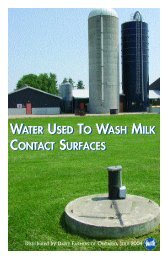Canadian Quality Milk On-Farm Food Safety Program - Centre ...
Canadian Quality Milk On-Farm Food Safety Program - Centre ...
Canadian Quality Milk On-Farm Food Safety Program - Centre ...
You also want an ePaper? Increase the reach of your titles
YUMPU automatically turns print PDFs into web optimized ePapers that Google loves.
<strong>Canadian</strong> <strong>Quality</strong> <strong>Milk</strong><br />
9.4 COMMUNICATION AND CORRECTIVE ACTION<br />
PLANS<br />
Corrective action plans outline the steps family and staff should take to correct problems<br />
that may occur. Corrective action plans should contain detailed instructions and contact<br />
numbers.<br />
To prepare for an emergency situation, you must have written corrective action plans on<br />
how to communicate and address the following situations. The Workbook contains a<br />
sample form (Record 16).<br />
9.4.1 Medicines and Chemicals Used on Livestock:<br />
You must have a written corrective action plan for incorrect administration of<br />
medications or other chemicals to an animal. Some possible actions are:<br />
• Call a veterinarian to discuss withdrawal times and possible residue concerns.<br />
• Call provincial regulatory authority for assistance.<br />
• Use appropriate test kit to check for residues.<br />
• If milk is unmarketable, dump the milk in an environmentally acceptable manner.<br />
• Review and revise SOP control measures to avoid a reoccurrence.<br />
Reminder: All problems that occur regarding animal treatments and the<br />
corrective actions taken must be recorded on Record 17 in the Workbook.<br />
See Chapter 4, Section 4.4 for more information on administration of treatments.<br />
9.4.2 <strong>Milk</strong>ing Treated Animals<br />
You must have a written corrective action plan for the entry of milk from a treated animal<br />
into the bulk milk tank. Some possible actions are:<br />
• Put a note in a prominent place on the bulk tank warning the driver not to pick up<br />
the milk.<br />
• Notify the transporter.<br />
• Call milk regulatory authority for assistance.<br />
• Use appropriate test kit to check for residues. If the sample is positive, another<br />
sample may be sent to a laboratory for an official test.<br />
• If milk is unmarketable, dump milk in an environmentally acceptable manner.<br />
• Review and revise SOP and implementation to avoid a reoccurrence.<br />
Reminder: All problems that occur regarding milk residues and the<br />
corrective actions taken must be recorded on Record 17 in the Workbook.<br />
See Chapter 5, Section 5.2.3 for more information on milking treated animals.<br />
June 2010 9—5
















